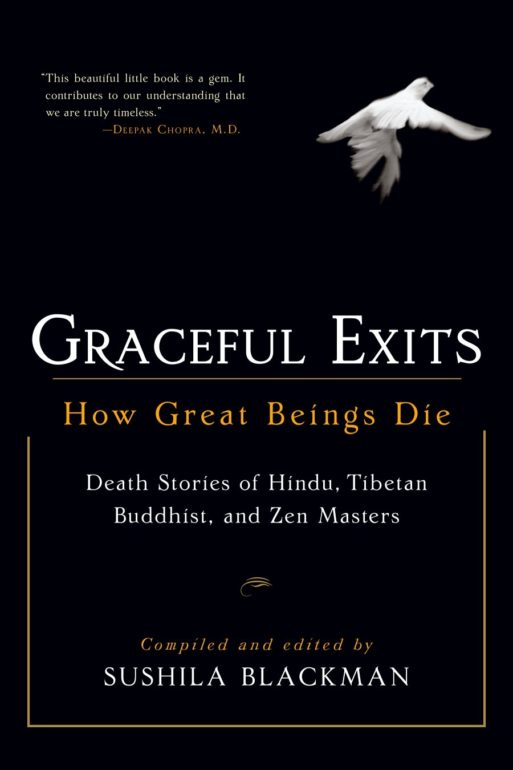 “Graceful Exits: How Great Beings Die – Death Stories of Hindu, Tibetan, Buddhist, and Zen Masters,” was compiled and edited by Sushila Blackman in 1997, as she herself, both knowingly and unknowingly prepared to die.
“Graceful Exits: How Great Beings Die – Death Stories of Hindu, Tibetan, Buddhist, and Zen Masters,” was compiled and edited by Sushila Blackman in 1997, as she herself, both knowingly and unknowingly prepared to die.
This book is not necessarily an instruction manual on how to die with grace, but it can provide inspiration to help the reader re-frame his or her perspective of death, fear it less, and hopefully be prepared for it when it comes. How? By perceiving death as the Masters in this book did — as an inevitable and natural transition of the soul. These masters see death as an integral part of life, and they accept it with dignity and grace. Thus, death becomes the final lesson that these masters teach their students (and anyone else interested enough to learn).
“Graceful Exits” itself is an uplifting collection of 108 stories (all sourced) that focus on the moments of death by both contemporary and ancient Buddhist, Zen, and Hindu spiritual masters, all of whom seem fully prepared to meet death. After all, to the Zen, Buddhist, or Hindu spiritual practicioner, even though the body ceases to function, the soul continues to exist, like “water going back to water.” To them, to die is nothing special.
“When the tenth century Chinese Zen Master name Dasui Fazhen was asked, “How are you at the time when life-death arrives?” He answered promptly, “When served tea, I take tea; when served a meal, I take a meal.” (Story 45, Pg. 73)
The stories are easy-to-read and reveal a remarkable range of unique personalities and bits of humor, wisdom, joy, and grace. I enjoyed flipping through the book in no particular order, and sitting and contemplating the stories that spoke to me. There were some stories that didn’t interest me, and those were the few that included fantastical or bizarre ends –bodies disappearing completely, sparks flying out of mouths, and so on. However, even here, the fundamental message of accepting death with grace is preserved.

The book begins with a 17-page introduction that provides a background to Hindu, Buddhist, Zen and Tibetan beliefs around death, reincarnation, and enlightenment. This can be very helpful if you’re unfamiliar with these beliefs and practices, and slightly unnecessary if you’re well-versed.
I highly recommend you read the afterword: Here is where Blackman shares the experience of creating this book after the death of her guru, Swami Muktananda, and the death of her mother and father. A few months before completing her book, Blackman herself was diagnosed with metastasized lung cancer, and notes that she had, “unknowingly, been busy compiling a training manual for my own ‘graceful exit!”
All in all, this book is inspirational, but not for everyone. As Blackman writes at the end of the introduction: “This book is written for those who are on, or who aspire to be on, the spiritual path. It is written for seekers. This term, as I use it, is very broad. It includes all those who consider the unseen in life to be their true source of nourishment, sustenance, and joy.”

 “Graceful Exits: How Great Beings Die” by Sushila Blackman
“Graceful Exits: How Great Beings Die” by Sushila Blackman


 How Dare You Die Now!
How Dare You Die Now!
 Debating Medical Aid in Dying
Debating Medical Aid in Dying
 “Help Me, Helen”
“Help Me, Helen”














